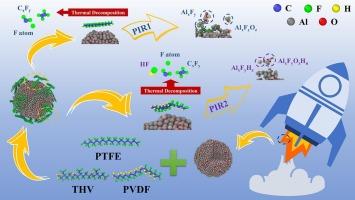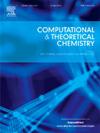不同的预燃反应机理改善含氟聚合物的燃烧,含氟量不同的含铝颗粒
IF 3
3区 化学
Q3 CHEMISTRY, PHYSICAL
引用次数: 0
摘要
利用含氟聚合物对铝粉进行改性,可以提高燃烧效率。不同的含氟聚合物已经观察到不同的效果,但原因尚不清楚,因此本工作采用ReaxFF-MD方法结合点火实验研究了PTFE, PVDF, THV与纳米Al颗粒(ns-Al)的相互作用过程。不同含氟聚合物与ns-Al的预燃反应机理不同。对于不含H的PTFE,其F原子直接与氧化层反应生成AlxFy或AlxOyFz。这被称为PIR1。在含H PVDF和THV中,F原子和H原子与氧化层反应生成AlxFyHz或AlxOyFzHn,分类为PIR2。两种PIR机制表现出显著差异。这些结果揭示了不同氟含量的含氟聚合物在原子水平上促进ns-Al点火和燃烧的差异。本文章由计算机程序翻译,如有差异,请以英文原文为准。

Different pre-ignition reaction mechanisms for improving the combustion of fluoropolymers, containing different fluorine contents with aluminum particles
The use of fluoropolymers to modify aluminum (Al) powder has been demonstrated to improve the combustion efficiency. Different fluoropolymers have been observed to exert varying effects, but the reason remains unknown, so this work employs the ReaxFF-MD method combined with ignition experiments to examine the interaction process between PTFE, PVDF, THV and nano-sized Al particles (ns-Al). The pre-ignition reaction (PIR) mechanism of different fluoropolymers with ns-Al is distinct. For PTFE without H, its F atoms directly react with the oxide layer to form AlxFy or AlxOyFz. This is referred to as PIR1. In H-containing PVDF and THV, the reaction between F atoms and H atoms with the oxide layer generates AlxFyHz or AlxOyFzHn, which is classified as PIR2. The two PIR mechanisms exhibit notable differences. These results reveal the difference in the promotion of ns-Al ignition and combustion by fluoropolymers with different fluorine contents at the atomic level.
求助全文
通过发布文献求助,成功后即可免费获取论文全文。
去求助
来源期刊

Computational and Theoretical Chemistry
CHEMISTRY, PHYSICAL-
CiteScore
4.20
自引率
10.70%
发文量
331
审稿时长
31 days
期刊介绍:
Computational and Theoretical Chemistry publishes high quality, original reports of significance in computational and theoretical chemistry including those that deal with problems of structure, properties, energetics, weak interactions, reaction mechanisms, catalysis, and reaction rates involving atoms, molecules, clusters, surfaces, and bulk matter.
 求助内容:
求助内容: 应助结果提醒方式:
应助结果提醒方式:


